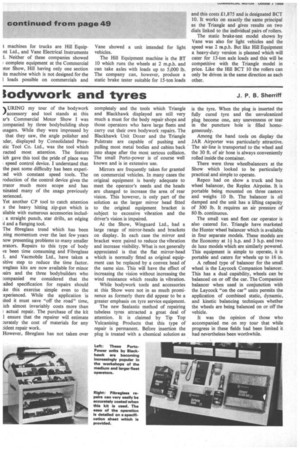lodywork and tyres J. P. B. Sherriff NURING my tour
Page 52

If you've noticed an error in this article please click here to report it so we can fix it.
of the bodywork !accessory and tool stands at this ar's Commercial Motor Show I was ompanied by three bodybuilding shop inagers. While they were impressed by that they saw, the angle polisher and Ider, displayed by Consolidated Pneuttic Tool Co. Ltd., was the tool which racted most attention. The feature ich gave this tool the pride of place was speed control device. I understand that the past some difficulty has been experi:ed with constant speed tools. The reduction of the control device gives the :rator much more scope and has ninated many of the snags previously perienced.
Yet another CP tool to catch attention s the heavy hitting zip-gun which is 'liable with numerous accessories includ, a straight punch, star drills, an edging )l and a flanging tool.
The fibreglass trend which has been ning momentum over the last few years low presenting problems to many smaller erators. Repairs to this type of body ye been time consuming and Fibreglass 1. and Vacmobile Ltd., have taken a sitive step to reduce the time factor. neglass kits are now available for minor mks and the three bodybuilders who :.ompanied me considered that the :ailed specification for repairs should tke this exercise simple even to the xperienced. While the application is ited it must save "off the road" time, ich almost invariably costs more than : actual repair. The purchase of the kit I ensure that the repairer will estimate urately the cost of materials for any Hdent repair work.
However, fibreglass has not taken over completely and the tools which Triangle and Elackhawk displayed are still very much a must for the body repair shops and those operators who have large fleets and carry out their own bodywork repairs. The Blackhawk Unit Dozer and the Triangle Pulstrate are capable of pushing and pulling most metal bodies and cabins back into shape after the most serious collision. The small Porto-power is of course well known and is in extensive use.
Mirrors are frequently taken for granted on commercial vehicles. In many cases the original equipment is barely adequate to meet the operator's needs and the heads are changed to increase the area of rear vision. This however, is only part of the solution as the larger mirror head fitted to the original equipment bracket is subject to excessive vibration and the driver's vision is impaired.
At the Show, Winguard Ltd., had a large range of mirror-heads and brackets on display. In each case the mirror and bracket were paired to reduce the vibration and increase visibility. What is not generally appreciated is that the flat mirror-head which is normally fitted as original equipment can be replaced by a convex head of the same size. This will have the effect of increasing the vision without increasing the wind resistance which results in vibration.
While bodywork tools and accessories at this Show were not in as much prominence as formerly there did appear to be a greater emphasis on tyre service equipment.
The new Sealastic method of repairing tubeless tyres attracted a great deal of attention. It is claimed by Tip Top Vulcanising Products that this type of repair is permanent. Before insertion the plug is treated with a chemical solution as is the tyre. When the plug is inserted the fully cured tyre and the unvulcanized plug become one, any unevenness or tear in the puncture hole is filled homogeneously.
Among the hand tools on display the JAR Airporter was particularly attractive. The air-line is transported to the wheel and the 30 ft. of air hose is always conveniently rolled inside the container.
There were three wheelbalancers at the Show which looked to be particularly practical and simple to operate.
Repco had on show a truck and bus wheel balancer, the Replex Airpoise. It is portable being mounted on three castors and weighs 10 lb. The balancer is oil damped and the unit has a lifting capacity of 300 lb. It requires an air pressure of 80 lb. continuous.
The small van and fleet car operator is also catered for. Triangle have marketed the Hunter wheel balancer which is available in four separate models. These models are the Economy at 1+ h.p. and 3 h.p. and two de luxe models which are similarly powered. This equipment is simple to operate, it is portable and caters for wheels up to 16 in.
A refined type of balancer for the small wheel is the Laycock Companion balancer. This has a dual capability, wheels can be balanced on or off the car. The Companion balancer when used in conjunction with the Laycock "on the car" units permits the application of combined static, dynamic, and kinetic balancing techniques whether the wheels are being balanced on or off the vehicle.
It was the opinion of those who accompanied me on my tour that while progress in these fields had been limited it had nevertheless been worthwhile.




















































































































